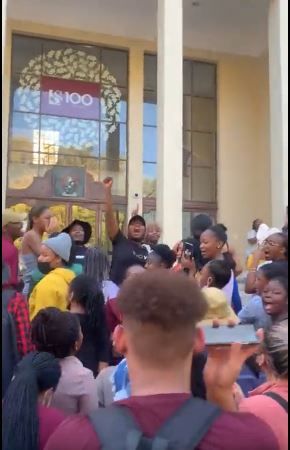Students protest at Stellenbosch Universtity
Apartheid was legally abolished in 1994 making way for the birth of the rainbow nation. The term was coined by Archbishop Desmond Tutu and was meant to symbolise the diversity and unity of our country. However, as time goes by, the apparent rainbow nation seems to grow dimmer. The repercussions of apartheid are still very much prevalent in society.
A white Stellenbosch University student was recently caught on video urinating on a black student’s belongings. He can be heard making racist remarks to the black student without hesitation. While the video went viral, it has been reported this is not first incident of racism.
The student appeared confident in his actions. Before leaving, he remarks, “It is what white boys do to black boys.” Evidence that the lasting effects of the apartheid system is still present in the mindset of many South Africans.
What influences the remains of racism?
Racism is seen as normal at Stellenbosch University. It has created a culture that makes incidents like this seem justifiable to certain students. Dr Saths Cooper, anti-apartheid activist and current president of the Pan African Psychology Union, reveals the significant role the country’s history has played in creating this culture at the university.
“There hasn’t been the clear denunciation by the university in that way where this happened. The university needs to look at the enabling environment it created for racism to perpetuate itself and indeed flourish and brandish itself in the kind of ways, that the perpetrator has been allowed to do. If the university was the place where human rights were valued, people are valued, because you are part of the human family, this incident would not have happened. It is because of the differences because of the deviation.”
The university has become a reflection of its town. One where the person of colour may feel like an alien when walking the streets. Sifiso Zungu, Western Cape provincial chairperson of SASCO (The South African Students Congress), highlighted that Stellenbosch, as a town, was made for the white man.
“Perhaps Stellenbosch University is known from its origin that it was never designed for black people, coloured people, or Indian people. It was just mainly for white people. What is happening today is many white people are not even sure, where they are in 2022 in terms of racism right.”
Change is necessary
Dr. Cooper added to Zungu’s statements revealing, “In 1918, just soon after it was created as a university, Wilcox became the first head of psychology. He went on to become the principal of the university and indeed the psychology building is called the Wilcox building. Let me tell you the kinds of people who came from psychology there are racist to the core.”
Although the university is largely at fault, we must shift our questions to higher authorities for intervention. Stellenbosch University has previously been condemned by the government for the way it operates and was asked to implement a much faster process of transformation. The university accepted the conditions revealing they would pump more money in doing so. Yet, little or no change has been made.
The government has failed us in terms of doing the bare minimum. Zungu explains how the government has contributed to the existence of this culture at the university.
“Fast forward five years or six years later, does the government follow up on Stellenbosch University and check how far are they with their transformation agenda? No. The minister of higher education, if he can be sanctioned now and be asked when he last checked the commitments that he said in 2015, was going to be done in terms of monitoring the Stellenbosch University in terms of transformation. How far are you/ How fast Stellenbosch has gone from 2015 to 2022. I don’t think minister of higher education has an idea around that because why, many politicians’ problem is that you will hear around the times of elections in South Africa many politicians speaking about Stellenbosch, but you will never find one politician coming here to address those problems.”
How do we shift to an embracing mindset?
Considering this incident, along with every incident in the past, it is most certain there must be some form of radical change that takes place in the mindset of the people at the university, in the town, and in the country in fact.
Dr, Cooper suggests we if we had an equated and empowering system of education, we could see change in the mindset. “[The] Adult older generation are failing the children yet to be born. By allowing what is patently an injustice to the basic humanity of our kids.”
Education and acknowledgement were key parts in helping most people born after 1994. The same needs to be applied to transform the remains of racism that we see scattered through our society. Julie Allie in conversation with Dr Saths Cooper and Sifiso Zungu about the Stellenbosch urinator incident.

